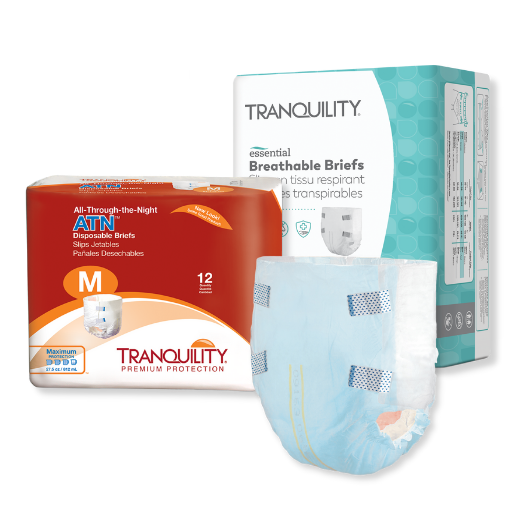Posted by Robert Recker on Jan 03, 2022
Diapers with Wetness Indicators: What are They and How do They Work?
People who are managing incontinence may have very different experiences from one another. One person may have very light urinary leakage, while another may have very heavy urinary leakage combined with fecal / bowel incontinence. That is why disposable absorbent products such as adult diapers (also referred to as “tab-style briefs”) and pull-on underwear offer a range of absorbencies, from light to moderate to heavy protection, so people can select the level that meets their specific needs. However, no matter how much absorbency a product provides, it cannot protect its wearer from leakage, odor and potential skin issues if it is not changed in an appropriate time period.
Fortunately, one product feature that has come a long way in helping people and their caregivers understand when a product change is needed is the wetness indicator.

What is a wetness indicator?
Popularized as a feature in baby diapers and youth training pants as far back as the 1970s, a wetness indicator is designed to let the wearer or their caregiver see or sense when a product has reached its capacity and needs to be changed. Some products use a “fade when wet” approach, where icons or images printed on the outside of the product begin to blur when moisture is present and fully disappear when fluid capacity is reached. A less popular, and potentially problematic, method is a “feel wet” feature that restricts some voided fluid from absorbing into the product core, producing a moist feeling on the skin that tells the wearer to change the garment. Finally, some brands use a “color change” method in which a line or other printed mark on the outside of the product changes to a specific color in the presence of moisture, to indicate a new product is needed.
How do color-change diaper wetness indicators work?
Most disposable absorbent briefs or adult diapers use the color-change style of wetness indicator. When moisture or acidity from urine is found, a colored line will change from yellow to blue. One type of chemical used for this purpose is bromophenol blue. When bromophenol blue is exposed to a specific pH level, it will change color, indicating that urine is present.
The most effective color-change systems change color rapidly once moisture is sensed and use a distinct set of colors that are easy to tell apart, even if a caregiver is checking at night, in low lighting.
It should be noted that wetness indicators are generally activated by urine absorption and are not designed to make the wearer or caregiver aware that a bowel movement has taken place. Products should always be changed promptly following a fecal incontinence episode.

Why are wetness indicators important?
As noted previously, even the best-performing and most absorbent products can’t keep their wearer dry, comfortable and healthy if they are left on the body for too long. Studies show that when an absorbent product has reached capacity and urine is exposed to the skin for as little as 15 minutes, skin issues can begin to develop, which can eventually lead to annoying rashes, painful wounds or serious infections.
Babies and young toddlers who are not potty-trained may cry or act agitated when their diaper is wet, which tells their parent or caregiver it’s time to change them. However, some children and adults, including older adults, people with dementia or those with development disabilities, intellectual disabilities or other complex healthcare needs, may not be able to sense when their incontinence garment is overfilled. A wetness indicator helps their caregivers determine when a change is needed.
Lastly, wetness indicators not only signal when it’s time for a product change, they can also help to reduce waste by ensuring caretakers only change the product when it is necessary.
Wetness indicator advancements
The future of wetness indicators is evolving with new technologies that will one day replace color-fade, color-changing or “feel wet” methods. New “smart absorbent products” are being developed, which feature a small wireless transmitter on a disposable garment to track how much fluid it has absorbed. This information is sent in real-time to a smart phone, tablet or computer dashboard to indicate when a product change is needed, track urination patterns, and to record that data as part of the wearer’s vital health statistics.

What diapers have the wetness indicator?
Wetness indicators are found on most quality adult disposable absorbent briefs on the market. For instance, Tranquility®offers a wetness indicator on all eight of its tab-style brief products. It’s worth noting that wetness indicators are less likely to be found on adult pull-on underwear than on adult diapers or tab-style briefs. This is because diapers/briefs are more commonly used by those who require assistance when changing their product; therefore, the wetness indicator is used by both them and their caregiver to signal when it’s time for change.
While a wetness indicator is a helpful feature, making sure to use the right product style with the right fit is critical for stopping leaks and reducing the number of changes needed (this product quiz can help you get started). Absorbent products should always be changed before the skin shows any signs of moisture, to maintain proper skin health.
If you need help selecting the right products for your needs, please call a Comfort Plus representative at 1-888-656-8055 or email service@comfortplusonline.com.

Robert Recker
Robert is a Senior Manager of Content Marketing for a leading continence care product manufacturer. He has over 15 years of experience creating online educational content, including the last dozen years in the healthcare industry, specializing in medical supplies.
For more information or questions about this article, please call Comfort Plus at 1-888-656-8055 or email service@comfortplusonline.com.
Related Articles

